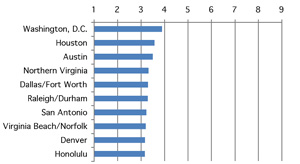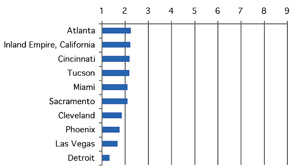A recent report by the Urban Land Institute and PricewaterhouseCoopers projects that most development sectors will not recover until 2012 or even 2013. The office, industrial, retail, and hotel sectors will all fare poorly, according to the study, which was released November 5 during the ULI’s annual conference in San Francisco.
But the report offered hope to some. It said that niche sectors including medical, senior housing, and student residences could buck the otherwise dire trend, and apartment development could resume by late 2011. The report adds that urban infill and transit-oriented projects will be the first to break ground once the upturn arrives.
Architects who attended the ULI conference reacted with dismay to projections that commercial and multi-family development will continue to stagnate in the next two years. “We were all fearing that,” says Perkins + Will senior associate Gerry Tierney, AIA. “There’s a surplus of built product if you’re in the commercial field.” Adds Rob Steinberg, FAIA, president of California-based Steinberg Architects: “A lot of architects felt that if they were able to weather the storm, there might be some daylight next year.”
Some remain optimistic. James Dixon, AIA, vice president of California-based Nadel, says he doesn’t think the projections are 100 percent accurate. He notes that his firm is designing an office building in Riverside, California, whose developer has secured enough pre-leasing to begin construction. The firm also is working on a residential building in Hollywood with roughly 20 units, a distressed property that a developer bought and self-financed.
Susan Smith, director of the real estate advisory practice at PricewaterhouseCoopers, said the study focused on ground-up development rather than renovation. The latter could offer some hope for architects. “If you are able to do some moderate renovations on properties to make them more competitive in the market,” Smith says, “now is the time to do that.”
For more economic news, visit our special section, Recession & Recovery.





Post a comment to this article
Report Abusive Comment